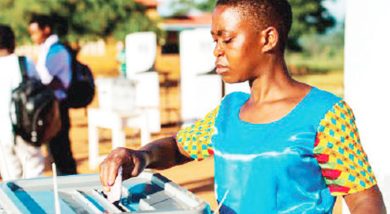Health budget at donors’ mercy
In every K100 spent in Malawi’s annual health budget, donors are responsible for K62 while government puts in about K25, it has emerged.
Effectively, the donors’ 62 percent contribution of the total healthcare expenditure compared to the Malawi Government’s estimated 25 percent, as revealed by Minister of Health and Population Atupele Muluzi at the joint annual review of the health sector last week, puts the health of Malawians at the mercy of development partners.

And a report on national budget commitments to nutrition also shows that about 93 percent of Malawi’s nutrition financing is from donors, with government providing a paltry 7.3 percent.
The report has since advised government to allocate more funding to nutrition in the national budget, noting that the prevailing dependence on donors is not sustainable.
Most of the donor fund go towards HIV and Aids, malaria, tuberculosis and immunisation, with donors such as the African Development Bank (AfDB) contributing K3.6 billion towards the procurement of essential drugs in the 2017/18 financial year alone, where the drug budget was K15 billion.
This financial year, K122 billion has been allocated to the health sector, but the drug budget for district and central hospitals is pegged at K14 billion.
The review report indicates that while the health budget has been increasing by an average of 12 percent annually, the real allocation has been lower, only increasing in 2017/18.
Muluzi confirmed that the health sector is largely financed by development partners.
He said: “Government is committed to progressively increase health sector financing through the fiscal budget and I would like to thank the development partners for the continued financial and technical support in the sector.”
The dependence on donors for the country’s health needs has also been observed in nutrition where the Eastern and Southern African National Budget Commitment to Nutrition Report commissioned by Care Action and the Graça Machel Trust ranked Malawi as the highest spender on nutrition in the region at 0.68 percent.
However, scrutiny and analysis found that the government was only spending $2.42 (about K1 815) per child annually while donors were spending $30.68 (about K23 010) per child. This puts the donors’ weight of contribution to nutrition at 92.7 percent, the report found.
The report has since advised the Malawi Government to prioritise increasing allocation to nutrition from the national budget as the current reliance on donors is not sustainable.
Reads the report in part: “Increase the spending per child as the current level is too small compared to the target of $30. The government should invest significantly in nutrition through Wash [Water, Sanitation and Hygiene] programmes given the bearing that water sanitation and hygiene have on nutrition outcomes.”
Nutrition encompasses vitamin A supplementation and exclusive breastfeeding and in the 2017/18 financial year, 2.5 million children (representing 88 percent of the targeted population) and 88 812 (55 percent) mothers received vitamin A supplements, according to a health sector performance report.
In the year under review, the country registered reduced hospital admissions for malnutrition, from 26 715 severe acute malnutrition to 21 017.
Civil Society Nutrition Alliance (Csona), which provided data for the report, has said the results have given them impetus to continue advocating for increased resource allocation in the national budget.
Csona programmes manager Bessie Ndovie said in an interview on Tuesday that although Malawi appears to have the highest budget allocation to nutrition, over 90 percent of the funding is coming from donors.
She said: “This is not sustainable and we are pushing the government to allocate more resources from its own purse in the event that donor taps run dry.”
Ndovie said in their analysis, ideally the government should be allocating three percent of its own national budget to nutrition and related activities.
To achieve this, Csona has embarked on a campaign to get the government to commit to increasing allocation from the current 0.9 percent to three percent in three years.
Ndovie said much as 0.9 percent might be adequate compared to other countries in the region, Malawi has made slow progress in implementing a nutrition-related policy that would put it in better light.
She said the government committed to enact the Food and Nutrition legislation in 2015 but the draft is yet to be submitted to Parliament for discussion.
Ndovie made similar observations on the draft nutrition policy which has only been approved this year.
The report also found that ministries of Health in the nine countries where the analysis was made were still getting the bulk of nutrition spending and nutrition was not mainstreamed or integrated into national development planning processes.
“Nutrition spending per child is low. Two countries [Malawi and Rwanda] met the Nutrition for Growth target of $30 per child, but both with support from donors.
“Nutrition specific spending is still high, meaning nutrition budget are not addressing the underlying causes and investment is not taking the multi-sectoral approach,” the report adds.
The study was conducted in eight other countries, namely Kenya, Madagascar, Mozambique, Rwanda, South Sudan, Tanzania, Zambia and Zimbabwe where similar trends were noted.
Besides Malawi, the report noted that donors also support a bulk of on budget nutrition support in Mozambique (67 percent), South Sudan (82.8 percent) and Zambia (67 percent).
In the Malawi Health Sector Strategic Plan (2017-2022), it is noted that health care financing in the country remains a challenge.
The plan shows that during 2012/13-2014/15, donors’ contributions accounted for an average 61.6 percent of total health expenditure (THE), with government putting in 25.5 percent and households 12.9 percent.
In the case of HIV and Aids subsector, donor contributions average 95 percent of total financing.
The five-year cost of the Health Sector Strategic Plan is estimated at $2.6 billion (about K1.9 trillion).





